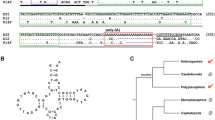Abstract.
Retrovirus-like sequences and their solitary (solo) long terminal repeats (LTRs) are common repetitive elements in eukaryotic genomes. We reported previously that the tandemly arrayed genes encoding U2 snRNA (the RNU2 locus) in humans and apes contain a solo LTR (U2-LTR) which was presumably generated by homologous recombination between the two LTRs of an ancestral provirus that is retained in the orthologous baboon RNU2 locus. We have now sequenced the orthologous U2-LTRs in human, chimpanzee, gorilla, orangutan, and baboon and examined numerous homologs of the U2-LTR that are dispersed throughout the human genome. Although these U2-LTR homologs have been collectively referred to as LTR13 in the literature, they do not display sequence similarity to any known retroviral LTRs; however, the structure of LTR13 closely resembles that of other retroviral LTRs with a putative promoter, polyadenylation signal, and a tandemly repeated 53-bp enhancer-like element. Genomic blotting indicates that LTR13 is primate-specific; based on sequence analysis, we estimate there are about 2,500 LTR13 elements in the human genome. Comparison of the primate U2-LTR sequences suggests that the homologous recombination event that gave rise to the solo U2-LTR occurred soon after insertion of the ancestral provirus into the ancestral U2 tandem array. Phylogenetic analysis of the LTR13 family confirms that it is diverse, but the orthologous U2-LTRs form a coherent group in which chimpanzee is closest to the humans; orangutan is a clear outgroup of human, chimpanzee, and gorilla; and baboon is a distant relative of human, chimpanzee, gorilla, and orangutan. We compare the LTR13 family with other known LTRs and consider whether these LTRs might play a role in concerted evolution of the primate RNU2 locus.
Similar content being viewed by others
Author information
Authors and Affiliations
Additional information
Received: 29 September 1997 / Accepted: 16 January 1998
Rights and permissions
About this article
Cite this article
Liao, D., Pavelitz, T. & Weiner, A. Characterization of a Novel Class of Interspersed LTR Elements in Primate Genomes: Structure, Genomic Distribution, and Evolution. J Mol Evol 46, 649–660 (1998). https://doi.org/10.1007/PL00006345
Issue Date:
DOI: https://doi.org/10.1007/PL00006345




